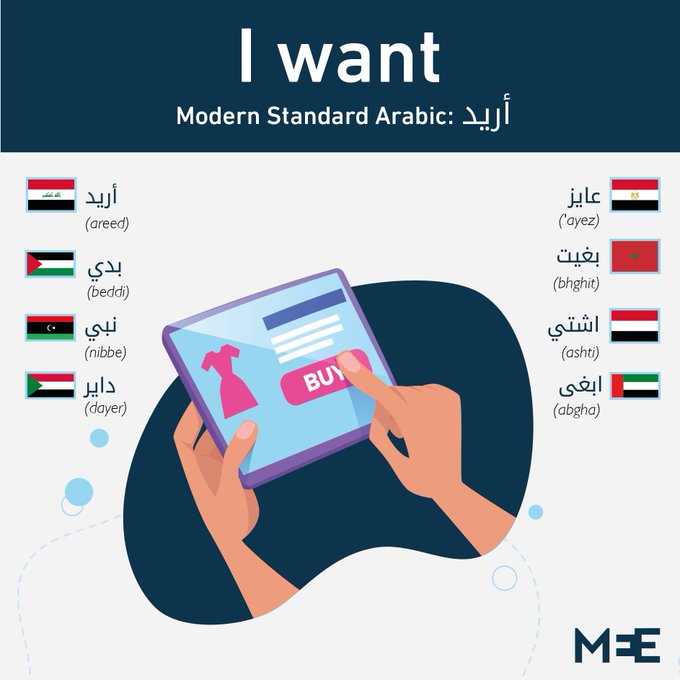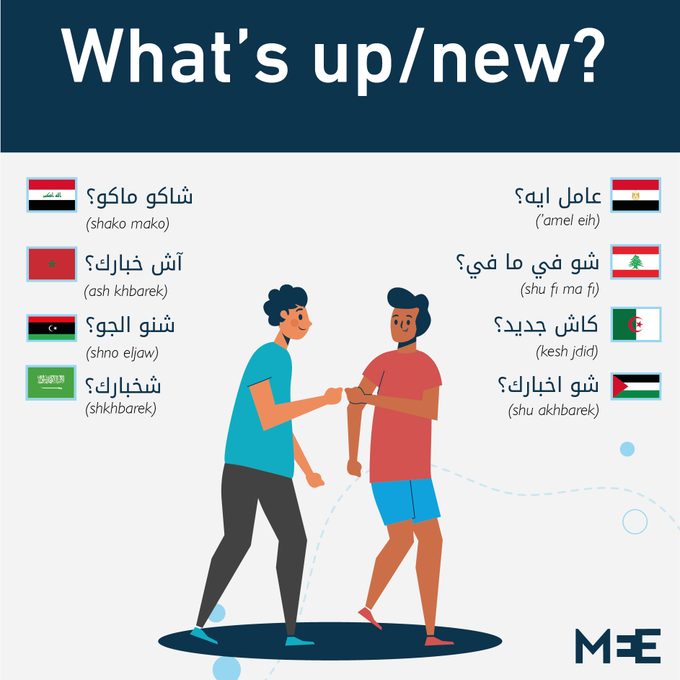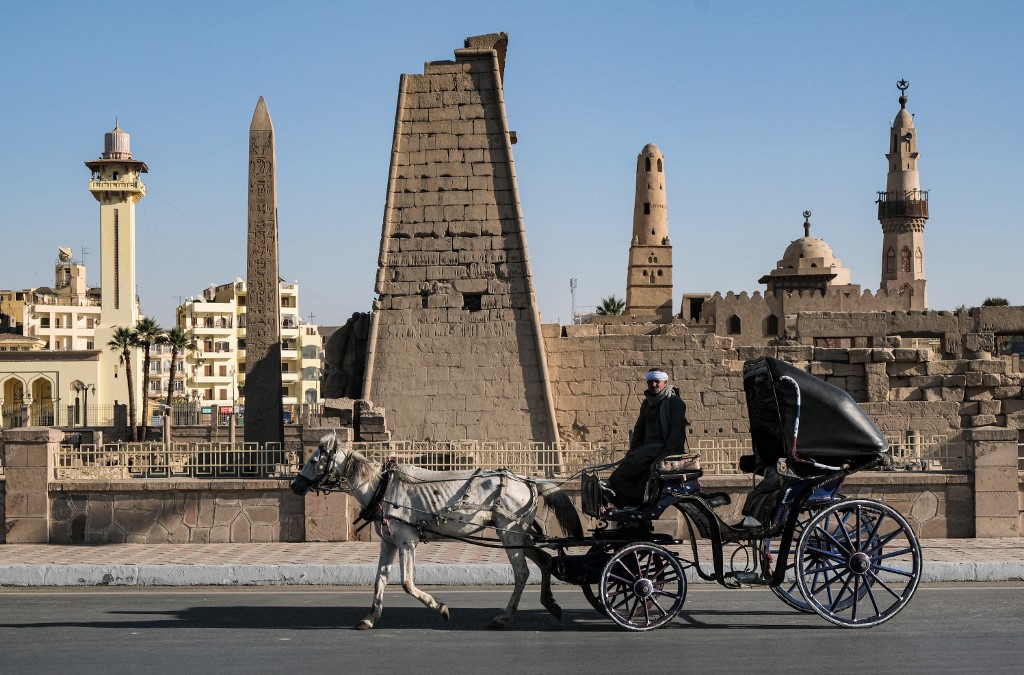Shou, shinou, ey: Five major Arabic dialects and what makes them unique

With at least 350 million speakers, Arabic is the fifth most spoken language in the world after English, Mandarin, Hindi, Spanish and French.
However, the kind of Arabic you hear on the streets of the Middle East and North Africa might differ dramatically from one country to another.
Differences between the Maghrebi dialect spoken in North Africa, for example, and the Iraqi dialect (Mesopotamian) might be so drastic that native speakers of each may not be able to make out more than a few words.
Given this lack of mutual intelligibility, one might wonder why they are not considered separate languages, and that's a question linguists continue to debate.
The answer is rooted in both politics and history.
Stay informed with MEE's newsletters
Sign up to get the latest alerts, insights and analysis, starting with Turkey Unpacked
All Arabic dialects spoken today, whether in North Africa or the Gulf have a common origin in the forms of Arabic spoken in the Arabian peninsula around the formation of Islam in the early seventh century.
These dialects spread with the advance of Muslim armies to new lands across the Middle East and North Africa and later developed into the forms we know today.
One particular form, however, has remained a standard dialect common to all educated Arabs.
Modern Standard Arabic (MSA), also referred to as fus'ha, is a close relative of the Classical Arabic used in the Quran and is used today in all formal contexts, such as in education, news broadcasts, formal political statements, and religious sermons.
It is this dialect that unites Arabic speakers, whether they are in Morocco or Oman, and when two speakers from geographically distant lands encounter one another, their speech will take on a more formal character to ensure they are understood.
There are a number of reasons why dialects differ and again this is a topic linguists continue to debate.
When Arabic speakers spread to new lands, their language often took on characteristics of the languages that were already spoken in those areas. So, in formerly Persian lands, there would be Persian linguistic influence; in North Africa, Berber influence, and so on.
Later invasions by Turkic and Iranian warriors also left a mark on language, as did the more recent colonialist endeavours by Europeans, such as the French in Algeria and the British in Egypt.
Trade was another way new words were introduced with the Gulf region, in particular, taking on vocabulary from merchants comings from South Asia.
Today regional dialects are a key component of national identity in the Arab world and Arabic speakers are likely to take pride in their own vernacular.
In this non-exhaustive list, Middle East Eye takes a look at the five major Arabic dialects and what makes them unique:
1. Egyptian
The Egyptian dialect is the Arab world's most spoken Arabic dialect with close to 100 million people using it in everyday life and tens of millions more outside of the country familiar with it, as a result of the popularity of Egyptian media.
Its most distinctive feature is the use of "g" sound in place of the "j" sound used in formal Arabic. The word najm (star) in MSA will be pronounced negm in the Egyptian dialect.
Egyptian Arabic is perhaps the most widely recognised Arabic dialect due to the popularity of Egyptian films and television shows.
The dialect has been considerably influenced by French and English - as well as Turkish - due to centuries of Ottoman rule.
French-derived words include bantalon, which means trousers, and kawafir meaning barber.
Turkish words include kobri for bridge, and oda for room; the latter in MSA would be ghorfa.
The Egyptian dialect is closely related to the Sudanese variant of Arabic but the latter has retained the formal pronunciation of the letter "j", among other differences.
2. Mesopotamian
Mesopotamian Arabic is spoken in Iraq and Arabic-speaking areas of Iran, as well as parts of Syria, Kuwait, and southeastern Turkey.
The dialect contains influences from languages spoken in Mesopotamia in ancient times and today, including Sumerian, Akkadian, Persian, Kurdish, and Greek.
This dialect has two major varieties: the Gelet and the Qeltu, which are different ways of saying "I said".
In Iraq, the heavy dhad-sound is replaced by the lighter tha. So, for the sentence “he hit me” Iraqis will say tharabni rather than dharabni.
Depending on the area, the "q"- sound can be replaced with a "g" - a feature shared with Gulf dialects.
3. Levantine
The Levantine dialect, known in Arabic as Shami is spoken by 38 million people worldwide.
Varieties of the dialect are spoken in the Levant region, which includes; Syria, Lebanon, Jordan, and Palestine, as well as among small Arabic-speaking communities in Cyprus and Turkey.
Each variety is almost completely mutually intelligible with the other although with slight linguistic differences.
Many Arabic-language learners choose to learn the Levantine dialect due to its perceived closeness to MSA.
In the Levantine dialect, the th-sound is usually replaced with an “s” or “z” but accent-level differences are common across the region.
In Palestine, for example, the traditional qaf-sound can be replaced with “g” or “k” and the "k" sound can be replaced with “ch” depending on the area.
As with other variations of Arabic, Levantine contains Turkish influences, as well as more recent English and French additions.
Many linguists believe there is an Aramaic substrate within the dialect. The language was widely spoken in the Levant before the arrival of Islam.
4. Maghrebi
The Maghrebi (western) dialect spoken in North African states west of Egypt has a reputation for being difficult to understand among eastern Arabic speakers but that is a claim many North Africans would take issue with.
Locally, the Maghrebi variation of Arabic is known as Darija which translates to “everyday language".
It is used in the Maghreb region which includes Morocco, Algeria, Tunisia, Libya, Western Sahara, and Mauritania.
Maghrebi countries can understand others from the same region with relatively little trouble.
A distinguishing feature of the dialect family is the elision of vowel sounds. For example, "min ayna anta" (where are you from?) in MSA becomes "mnin nta" in Moroccan Arabic.
Depending on where it is spoken, the Maghrebi dialect includes considerable influence from other languages, such as French, Spanish, Turkish and Italian.
In Libya the influences are largely Turkish and Italian, while in Morocco they are French and Spanish.
There is also some influence from Berber languages, as Amazigh peoples have lived in the region for thousands of years, even before the arrival of Islam.
5. Gulf
The Gulf dialect, known in Arabic as “khaleeji” is spoken by almost seven million people.
This variation of Arabic is spoken in Saudi Arabia and around the coasts of the Gulf in Kuwait, Bahrain, Qatar, the UAE, southern Iraq, and northern Oman.
In some areas, the "q"-sound will be substituted for a "g"-sound, while the “k” is sometimes pronounced as “ch".
Influenced by Persian and Turkish, the Gulf dialect has also borrowed vocabulary from neighbouring regions and even contains some Hindi and English words.
As with each dialect group, the Gulf dialect varies slightly in every country and is easily mutually intelligible among Gulf Arabic speakers.
This article is available in French on Middle East Eye French edition.
Middle East Eye delivers independent and unrivalled coverage and analysis of the Middle East, North Africa and beyond. To learn more about republishing this content and the associated fees, please fill out this form. More about MEE can be found here.












